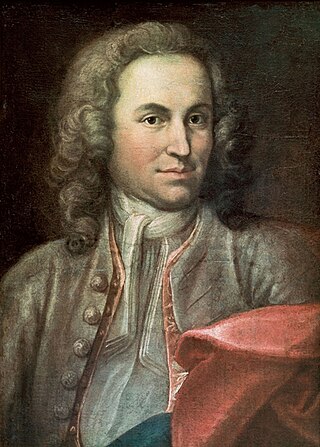Related Research Articles

Georg Philipp Telemann was a German Baroque composer and multi-instrumentalist. He is one of the most prolific composers in history, at least in terms of surviving oeuvre. Telemann was considered by his contemporaries to be one of the leading German composers of the time, and he was compared favourably both to his friend Johann Sebastian Bach, who made Telemann the godfather and namesake of his son Carl Philipp Emanuel, and to George Frideric Handel, whom Telemann also knew personally.
Johann Friedrich Agricola was a German composer, organist, singer, pedagogue, and writer on music. He sometimes wrote under the pseudonym Flavio Anicio Olibrio.
The trio sonata is a genre, typically consisting of several movements, with two melody instruments and basso continuo. It originated in the early 17th century and was a favorite chamber ensemble combination in the Baroque era.

Gottfried Heinrich Stölzel was a German composer of the Baroque era.

Johann Philipp Krieger was a German Baroque composer and organist. He was the elder brother of Johann Krieger.
The year 1697 in music involved some significant events.
Christoph Förster was a German composer of the baroque period.

Was mir behagt, ist nur die muntre Jagd, BWV 208.1, BWV 208, also known as the Hunting Cantata, is a secular cantata composed by Johann Sebastian Bach, belatedly for the birthday of Duke Christian of Saxe-Weissenfels on 27 February 1713. A performance lasts about forty minutes. The aria "Schafe können sicher weiden" is the most familiar part of this cantata.
Christian Friedrich Witt, or Witte was a German composer, music editor and teacher.
Adam Drese was a German composer, kapellmeister, and bass viol player of the baroque period.

Himmelskönig, sei willkommen, BWV 182, is a church cantata by Johann Sebastian Bach. He composed it in Weimar for Palm Sunday, and first performed it on 25 March 1714, which was also the feast of the Annunciation that year.
David Pohle was a German composer of the Baroque era. His surname is also spelled Pohl, Pohlen, Pole, Pol or Bohle.

Ahasverus Fritsch was a German jurist, poet and hymn writer of the Baroque era.
Johann Pfeiffer was a German violinist, concert master and composer of the late baroque period.
The Telemann-Werke-Verzeichnis, abbreviated TWV, is the numbering system identifying compositions by Georg Philipp Telemann, published by musicologist Martin Ruhnke.

Johann Sebastian Bach started composing cantatas around 1707, when he was still an organist in Arnstadt. The first documented performances of his work took place in Mühlhausen, where he was appointed in 1708.
The Thüringer Symphoniker Saalfeld-Rudolstadt is a symphony orchestra based at Rudolstadt in Thuringia.
Gustav Fock was a German music historian, editor early music and organologist. He is considered the most important Arp Schnitger researcher of his time.
Gelobet sei der Herr täglich is a church cantata by Philipp Heinrich Erlebach, for four voices, strings and continuo. The first movement is based on Psalm 68:20. Erlebach structured the composition in six movements, with the last movement repeating the first. The work is extant as a manuscript from around 1710. It has been recorded and performed.
References
- 1 2 3 4 Veen, Johan van (May 2006). "Philipp Heinrich Erlebach (1657–1714) / VI Sonate à Violino e Viola da Gamba col suo Basso Continuo, 1694". musicweb-international.com. Retrieved 1 July 2021.
- ↑ Digital Text of Book